How To Build Your Own Cannabis Grow Room
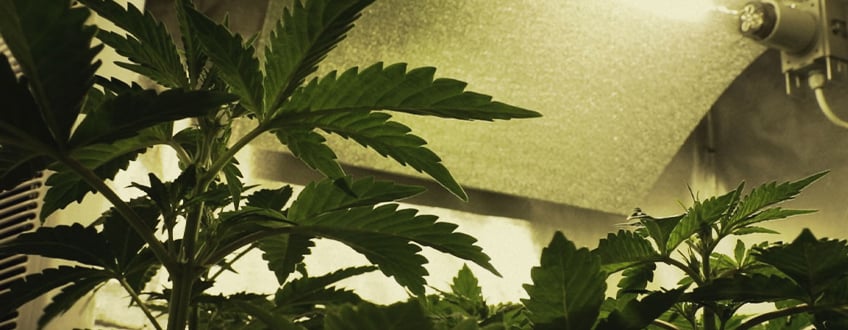
So, you have decided to grow your own cannabis at home. Nice one! Growing your own cannabis not only guarantees a continuous supply of wonderful weed, it also leads to a greater appreciation of the herb and the sense of a job well done. It is well documented that time in the garden is as beneficial as meditating, increasing one’s sense of well-being and even helping combat anxiety and depression.
Growing cannabis at home means having somewhere dedicated to growing. To produce enough weed to last from harvest to harvest, a minimum of 1m² is recommended. This will accommodate a number of smaller plants or one or two well-trained, or even scrogged, larger plants. All this is up to you; the yields in the end are similar, it just depends on whether you want a lot of variety with smaller yields per plant, or less variety and larger yields per plant. It is entirely up to the individual.
The height of the grow room is dictated by available space and lights being used. A single square metre is easily covered by most styles of grow light. Less height is required when using fluorescents, as lights can be kept closer to plants throughout the grow, whereas HID lights need more distance to avoid light burn and excessive heat buildup. You might want to blast your babies with a 1000W HID, but without appropriate height, this just isn’t possible.
Contents:
SELECTING A SPACE
Everyone can find an easily accessible spare square metre somewhere in their home or apartment. Spare rooms, attics, basements, cupboards, and walk-in robes can be used to set up a grow space. Discretion is a key factor; fan noise, light buzz, and odour control each need to be considered when selecting a space to set up a grow room. An oscillating fan attached to a shared partition wall, for example, will drive your neighbours crazy with the noise and sympathetic vibrations.
To avoid such issues, a growing tent kit can be a practical alternative. These enclosed setups provide a controlled environment that helps contain noise, minimize light leaks, and reduce odour dispersion
LIGHT PROOFING
An entirely light-proof grow room is absolutely necessary. In the first instance, light leakage can be annoying because grow lights are extremely bright. Light leakage can keep you awake at night if your grow room is a bedroom cupboard or set up in a spare corner of any inhabited room. At worst, it will advertise that you are growing weed to your whole neighbourhood.
Secondly, light leakage into the grow room can adversely affect plant performance. Once plants have been flipped to the 12-12 day/night cycle to induce flowering, light leakage can confuse plants and lead to a lower yield, hermaphroditism, or even failed crops due to light stress. All growers keep a keen eye out for male plants, but missing a few well-hidden bananas on females can ruin a whole crop by sending it into seed production.
Once your grow space is set up, do a test by turning on the lights and inspecting for any light leakage. Any cracks or holes that let light out will certainly let light in. When and if discovered, patch the holes with light-proof tape available at hardware shops or with at least two layers of gaffer tape—gaffer tape is semi-translucent, even the black stuff, so just one layer won’t do the job.
Most electrical equipment kept in a grow room, such as dehumidifiers, have quite bright micro-LED lights, which can do the same plant damage as environmental light leakage. Place a piece of tape over any lights on these types of appliances to ensure nights are the darkest of dark. Outdoors, the subdued light of the full moon has beneficial effects on plant growth, but this effect is difficult to translate to an indoor grow.
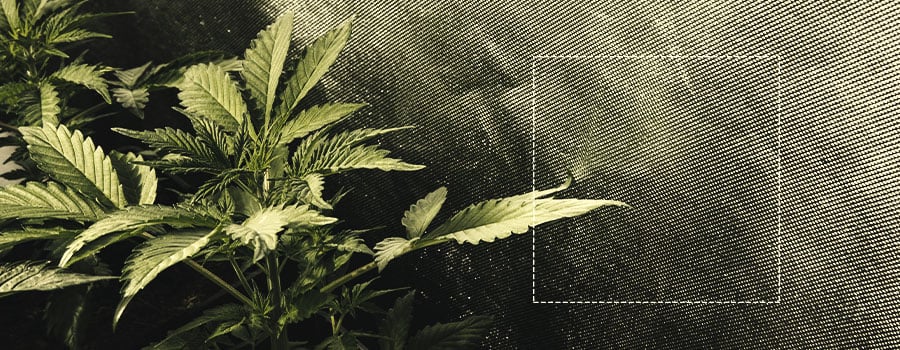
AIRTIGHTNESS
As it matures into resinous, fat buds, good cannabis smells—it’s as simple as that. Some weed even overpoweringly reeks and can stink out a whole room, a whole house, or even a street. It is easy to become used to that luscious aroma when visiting your plants often, and become convinced that the smell isn’t going further than your grow room—but nothing is further from the truth. A well-sealed grow room prevents aromas from disturbing neighbours or your fellow inhabitants.
A well-sealed grow room also makes climate control easier to maintain. Temperature control and dehumidifying/humidifying air rely on a sealed environment without any drafts. A stable environment is very important for optimum plant performance. A well-sealed room also acts as a quarantine cell for your plants, preventing any bugs, vermin, or airborne pathogens from entering. A single mouse can do a lot of damage to cannabis in only one night, especially to young plants, as they are voracious for nutrient-dense cotyledons and young stalks.
It should be noted that an airtight grow room is a low-budget solution. Spending more to set up an air exchange system will benefit your weed substantially and will pay itself back in the long run. However, airtight grow rooms are the ideal environments for experimenting with CO₂ enrichment for added plant performance.
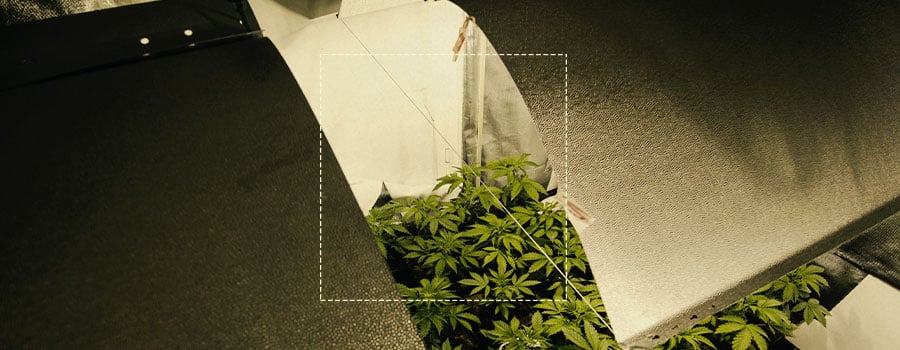
AIR MOVEMENT
Healthy cannabis requires moving air. Any grow room will require at least one oscillating fan to ensure air is continually in circulation. Moving air has a number of benefits for the cannabis plant.
At a minimum, moving air should ruffle all the leaves on a plant to ensure fresh air is available to the leaf stomata. In still environments, stale air can build up on the undersides of leaves around the stomata and hinder efficient gas exchange. This has the undesirable effect of inhibiting plant growth; stems will become weak, leaves will droop, and plant performance will be poor.
Moving air strengthens plants considerably; stems and stalks become thicker and more robust, and end yields will be higher.
Moving air also helps with the wet-dry cycle of the growing medium by supporting evaporation. Moreover, it prevents pathogens caused by moisture buildup on leaves as they transpire. Moulds like nothing more than a moist, warm environment.
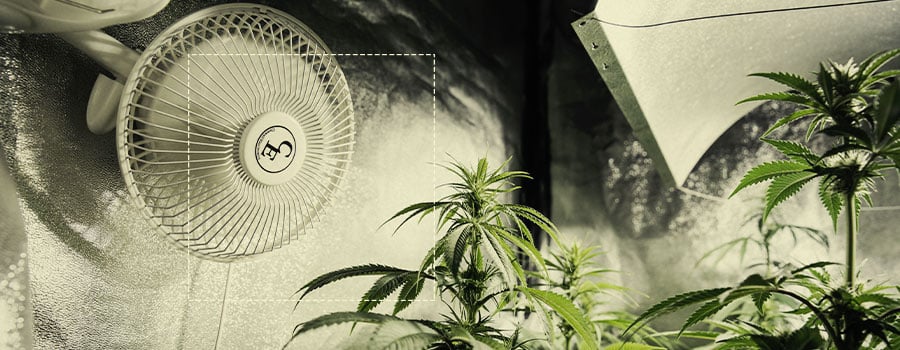
AIR EXCHANGE
With a higher budget, introducing an air exchange system stimulates better growth. Air exchange requires an inlet for fresh air and an exhaust for depleted air. With a higher budget still, incorporating a carbon filter into the exhaust system will keep the stink factor to a minimum.
Air inlets are passive and can take a number of forms; however, they are always situated in the lower part of the grow room, either in the floor if the floor is raised, or in a wall. The main consideration is light control when putting perforations into a grow room. A simple slot, vent, or series of holes will provide ample air intake, but can be indiscreet with light. Using a piece of ducting with a bend in it, or configuring a double wall arrangement, stops light escape. The easiest thing to remember is that light can’t go around corners, so introducing an arrangement with a bend of some kind keeps your grow discreet. Also, provide some kind of vermin barrier to dissuade any critters that want to get in and feed on your precious weed.
An air inlet means there will also be an air outlet or exhaust system, ideally with a carbon filter attached. Exhaust systems remove depleted air and heat from the grow room and draw fresh air in. Where possible, it is desirable to exhaust to the outdoors to prevent heat buildup in closed spaces, or to recirculate the same air back into the system. This can often be a challenge, but ducting is your friend when solving air distribution problems.
The capacity of an exhaust fan is dictated by the volume of the grow room. Length × width × height will give the volume of the grow room, and the manufacturer will recommend what fan will be right for the job. It is recommended to go up a size to ensure proper air exchange, and to accommodate any potential increase in the scale of your grow.
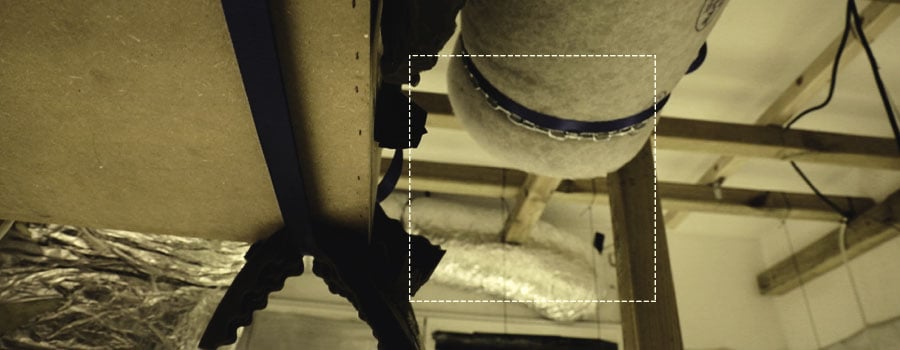
CLIMATE CONTROL
Cannabis thrives when the climate is controlled in regard to humidity and temperature, with certain parameters ideal for vegetation and other parameters ideal for bloom.
Humidity can be easily controlled with a dehumidifier; these are also available as double-action units that will add or subtract humidity as necessary. During vegetation, a humid and warm environment increases the rate of growth, while lower humidity and temperatures increase bud development.
Temperatures can be controlled with small, portable, reverse cycle AC units. Many humidity-modifying units and heaters come with built-in thermostats and hygrometers, so they switch on and off as the environment demands. Just set them, and rest assured your weed is booming at every stage; automating the whole thing makes growing life a lot easier.
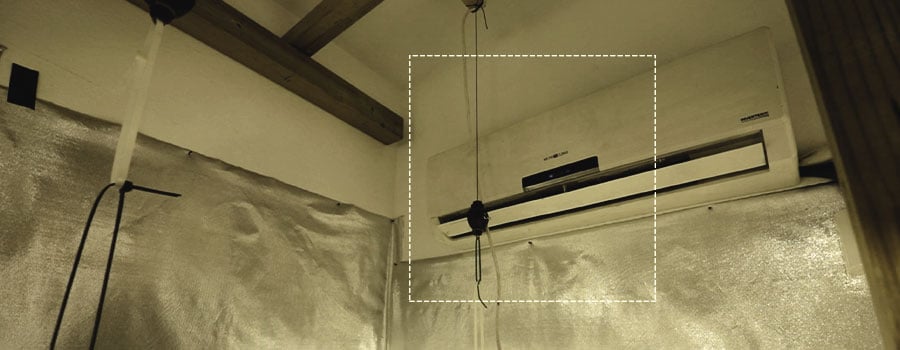
SAFETY AND FIRE PREVENTION
Although most growers make it to harvest time without any mishaps, numerous horror stories document how bad things can get when an accident happens.
-
ELECTRICAL EQUIPMENT
Although many cannabis growers like to keep their operation minimal, others like to use as many helpful gadgets as possible. But, even a small number of electronics in the grow space runs the risk of fire.
Water remains one of the biggest risks in the grow room when it comes to electronics. Water can interrupt an electrical current, potentially leading to a fire or electrocution. Try as hard as possible to keep electronics elevated above the ground in case of any water leaks.
Place a fan in your grow room to regulate temperature. Although this means even more electronics floating about, a fan will create a cool air current and help to prevent devices from overheating.
Using a ground fault circuit interrupter (GFCI) will help to stop electrical leaks when they arise. This piece of kit detects when electricity flows where it shouldn’t—in a pool of water or a human body— and breaks the circuit.
-
HOUSEKEEPING
Keep your grow room as tidy as possible. Create a dedicated space for each piece of equipment, and keep wires running neatly using plastic zip ties. If you notice any damaged or exposed wires, repair them immediately.
Clear away all tools after using them to prevent any trip hazards. Keep your pruning shears, watering cans, and spray bottles packed away in a toolbox when not in use. Not only can tripping result in injury, but you might also land on your plants and cause some serious damage.
-
FIRE EXTINGUISHER
Although rare, you should be entirely prepared for a fire to break out. Grow room fires can destroy your property, put your life at risk, and also expose your herbal hobby to the authorities. Keep a fire extinguisher close by at all times in case your setup goes up in flames.
Instal a fire alarm in your grow room to alert you if a fire breaks out. Purchase a handheld fire extinguisher and keep it at the entrance to your grow room or tent. Purchase a model that contains dry chemical powder or CO₂ suitable to tackle electrical fires. Alternatively, purchase an extinguisher ball and position it above your growing space. Upon exposure to excess heat, these devices explode and release fire-retardant powder.
.jpg)
THE BUILD
Now that you have selected a space that satisfies the demands for a healthy and discreet grow, it’s time to actually build your grow room. There are a number of solutions to create a grow room at home on a budget. This method uses a number of plastic-lined wooden frames to form the walls, base, ceiling, and door. When including a ceiling, supports for the grow lights will need to be incorporated. When dealing with existing walls and ceilings, BE ABSOLUTELY CERTAIN OF THE LOCATION OF ELECTRICAL WIRING. Also, tenants will need to consider the future repair of any surfaces that might be affected when building their grow room.
What you will need:
• A saw
• A stapler that can staple to wood
• Doubled-sided plastic sheet: one side black, the other side white or reflective like Mylar
• Screws
• 4 small hinges
• A drill with a drill bit and a screwdriver bit
• Scissors
• 26 angle plates
• Plastic corner protectors (optional)
• Timber to suit: 4x4cm (or close enough) pine or similar softwood is easy to handle, strong enough, and cheap; your local hardware shop will certainly have this available in a variety of lengths
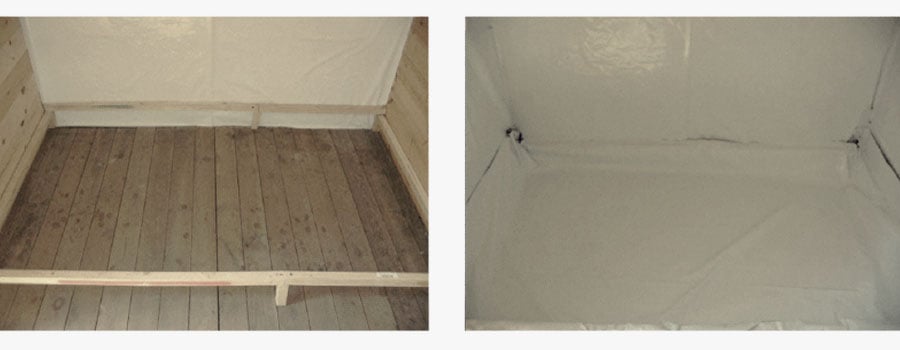
INSTRUCTIONS
1. To create the top and bottom of your frame, you will require 4x 1.0m + 5x 92cm laths of wood.
- To create the sides of your frame, you will need 7x 192cm laths.
- To create the door, you will need 2x 1.0m laths + 2x 192cm laths.
2. For the top: To affix the laths, drill holes 2cm from each end, and one in the middle for the spax. Do the same to the bottom. For the door: Drill holes 2cm from each end in the 1m laths. Spax together with the vertical beams.
3. Now that you have created the bottom frame, take one of the 192cm laths, place it in one corner, and affix it with two angle plates. Repeat in each corner.
4. Now that all 4 are in place, place the top and affix all vertical laths to it with angle plates.
5. Measure out the middle between the vertical laths and affix your stabilising beams with 2 angle plates (3 for where they meet the supportive beam of the top frame).
6. Using scissors, cut a piece of plastic/Mylar that will overlap every edge of each frame. Staple the plastic into place on the overlapping edge using plastic corner protectors.
7. Locate the door and screw the 4 hinges into place.
8. Voila, your grow room is now ready to be fitted out.
COLLECTION RACK
Building a collection rack in the floor of the grow room helps keep things neat and tidy. The plants in their pots are placed in this rack so that dirt spills and dead leaves and water runoff are collected then easily removed. When the grow is over, the collection rack is easily swept out and sterilised before the next grow.
To do this, you will build a frame that sits 15cm-deep inside your grow room and is lined with the same plastic used for the walls. This stops the actual floor of the room from becoming filthy and encouraging pathogens.
It is customary to flush plants at regular intervals during the grow, primarily to wash away any fertiliser salt buildup and to keep the medium in a cannabis-friendly nutrient range. Although there is no nutrient buildup in an organic grow, there is always some runoff. However, at the end of the flowering phase prior to harvest, all growing methods require a final flush to increase bud quality. The collection rack will catch all the runoff water, where it can be easily sopped up.
A collection rack can also act as a passive watering system if you are going to leave your plants unattended for a few days. Adding fresh water to the collection rack acts as a de facto reservoir, and plants will wick water up and not dehydrate while you are gone.
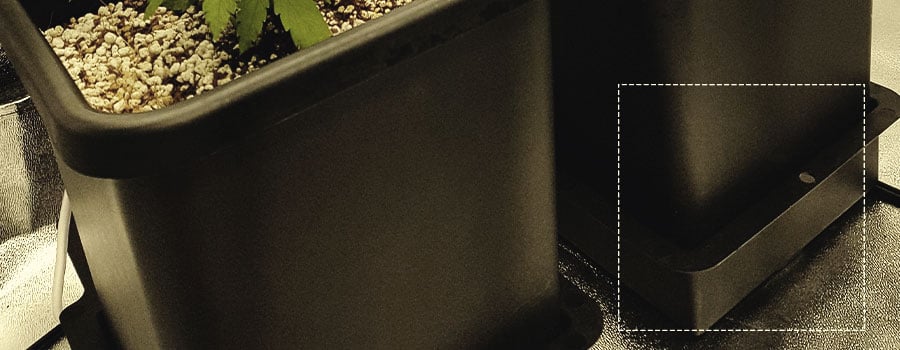
GET GROWING
You have now created a space that lets you grow your own cannabis at home. It lets in fresh air for healthy exchange of carbon dioxide, oxygen, and heat; it is light-tight for optimum plant health and discretion, and is clean and easy to maintain. Now, all you have to do is decide on whether you are going to grow organically or with nutrients, and select some killer strains to bring you joy!
Categories
Grow Cannabis With RQS


























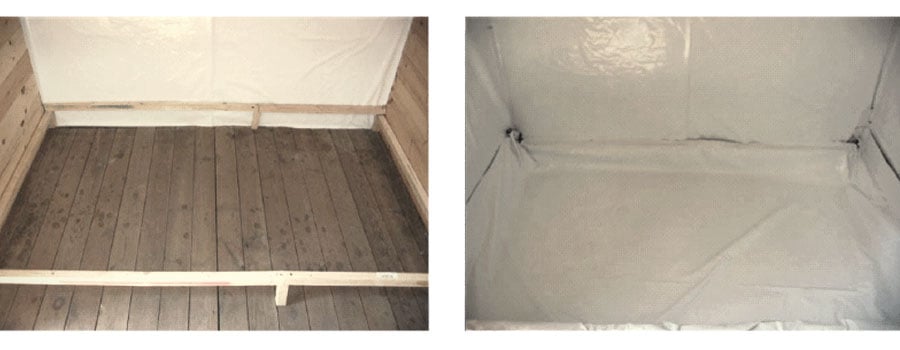
.jpg)







